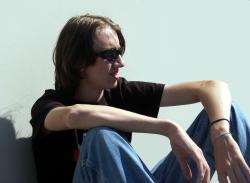Portrait Tips
 There is a long history behind portraits starting before cameras were even invented. There is a long history behind portraits starting before cameras were even invented.
 The painting below is by Albrecht Durer (1471-1528). The painting below is by Albrecht Durer (1471-1528).
Can you see similarities in the painting compared with photograph of Alex on the right? Both show a traditional pose with the subject's shoulders angled and face in the top third of the frame. |
|
| Portrait Tips: Use the wide angle and tele-photo "zoom" features of your camera. | |

|

|
| Camera lens set to telephoto mode produces a flat, compressed face. Don't take this to the extreme and you'll find it flattering for most portrait shots. | Camera lens set to wide-angle mode produces a distorted view. This is usually not used for portraits but can be used to produce interesting results. |

|

|
| This portrait of Sean used an extreme wide-angle lens. The computer lab setting becomes part of the portrait. Including the background to say something about the subject is typical of an environmental portrait.
|
This portrait of Alex is a traditional portrait. Only moderate telephoto zoom was used and the background is not distracting. The only flaw is the leaf attacking from the right side of the image. ;-) |
 Lighting is another important factor in portraits. Three of the photographs used soft, diffused lighting and one used lighting in a more aggressive way. Experiment with light in your portraits. Diffused light comes from all directions. You'll find this when your subject is in a shaded area or outside on an overcast day. The image of Slater (at right) used harsh light from a single source to help define the image. Lighting is another important factor in portraits. Three of the photographs used soft, diffused lighting and one used lighting in a more aggressive way. Experiment with light in your portraits. Diffused light comes from all directions. You'll find this when your subject is in a shaded area or outside on an overcast day. The image of Slater (at right) used harsh light from a single source to help define the image.
 Don't forget to experiment. Get in close for your portrait and try shooting from different angles. ;-) Don't forget to experiment. Get in close for your portrait and try shooting from different angles. ;-)
|
|
Last modified: Wednesday, 4 July 2012, 11:52 AM